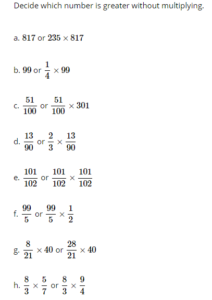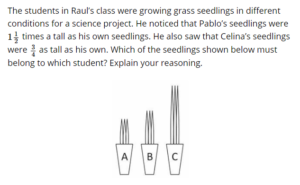MAFS.5.NF.2.5 – Interpret multiplication as scaling (resizing), by:
a. Comparing the size of a product to the size of one factor on the basis of the size of the other factor, without performing the indicated multiplication.
b. Explaining why multiplying a given number by a fraction greater than 1 results in a product greater than the given number (recognizing multiplication by whole numbers greater than 1 as a familiar case); explaining why multiplying a given number by a fraction less than 1 results in a product smaller than the given number; and relating the principle of fraction equivalence a/b = (n×a)/(n×b) to the effect of multiplying a/b by 1.
[divider] [/divider]
Students are able to…
- Reason about what will happen to the size of a product based on the relationship between the factors.
- Justify their thinking using pictures and models including area models, fraction strips, and number lines to support thinking.
- Explain that when multiplying a whole number greater than 1 by a fraction, the size of the product will be less than the whole number and greater than the fraction because they have more than one group of the fraction.
Students are able to…because teachers:
- Provide students with a variety of multiplication examples and problems in which one or both of the factors is scaled.
- Provide students with the opportunity to examine and predict the size of a product when they multiply a given whole number by a fraction, a given fraction by a fraction, and multiply with mixed numbers.
- Ask students to clarify their thinking, use examples, develop mathematical arguments, and make generalizations about the products of multiplication with fractions.
[divider] [/divider]
Questions to ask students:
- How does the product of 225 x 60 compare to the product of 225 x 30?
- Sample answer that indicates understanding: The product of 225 x 60 will be twice, or double, the product of 225 x 30 because 60 is double 30.
- Sample answer that indicates an incomplete understanding or a misconception: Student multiplies to find the two products separately and then compares the products. Although the student obtains the correct products of each expression, the student was unable to use strategic reasoning and had to multiply them to answer the question.
- Will the product of 3/4 × 6,350 be less than 6,350 or greater than 6,350? Explain.
- Sample answer that indicates understanding: Since ¾ is less than 1 whole, and any number multiplied by 1 is equal to that number, the product will be less than 6,350.
- Sample answer that indicates an incomplete understanding or a misconception: Student says that whenever you multiply, you always get a bigger number, so the product will be greater than 6,350.
[divider] [/divider]
FSA Notes
Cognitive Complexity Level: Level 3: Strategic Thinking and Complex Reasoning
Level 2: Intentionally left blank
Level 3: interprets and explains multiplication scaling by comparing the size of a product to the size of one factor on the basis of the size of the second factor, in a given situation, without performing the indicated multiplication
Level 4: generalizes and explains multiplication scaling by comparing the size of a product to the size of one factor on the basis of the size of the second factor, without performing the indicated multiplication
Level 5: Intentionally left blank
Assessment Limits:
- For given fractions in items, denominators are limited to 1‐20.
- Non‐fraction factors in items must be greater than 1,000.
- Scaling geometric figures may not be assessed.
- Scaling quantities of any kind in two dimensions is beyond the scope of this standard.
[divider] [/divider]
Additional Resources:
Additional in depth content knowledge:
Videos:
Multiplication of Fractions Progression (Part 1)
Predict the product of multiplying a fraction less than one by a whole number:
Sample Formative Assessment Tasks:
[divider] [/divider]
[divider] [/divider]

